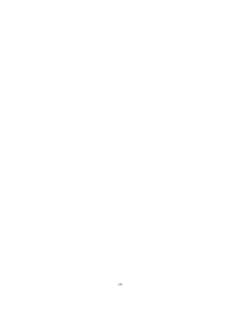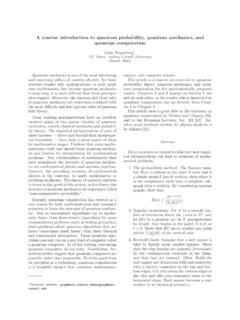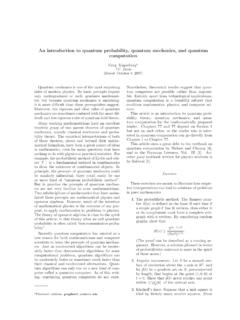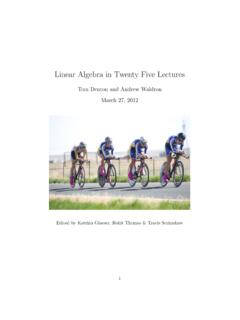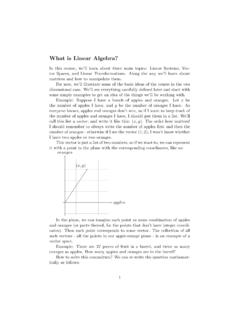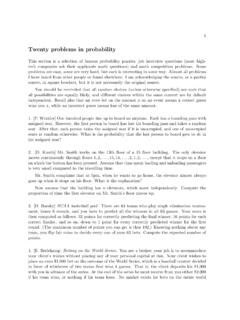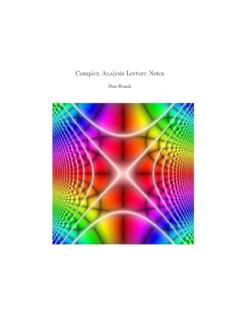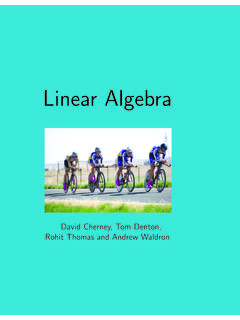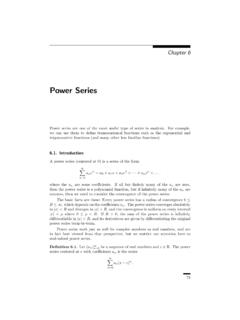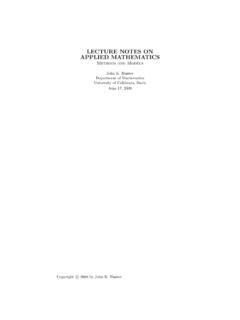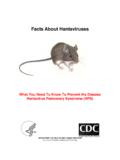Transcription of Chapter 3
1 Chapter3 Continuous FunctionsIn this Chapter , we define continuous functions and study their ContinuityAccording to the definition introduced by Cauchy, and developed by Weierstrass,continuous functions are functions that take nearby values at nearby nition :A R, whereA R, and suppose thatc A. Thenfiscontinuous atcif for every >0 there exists a >0 such that|x c|< andx Aimplies that|f(x) f(c)|< .A functionf:A Ris continuous on a setB Aif it is continuous at everypoint inB, and continuous if it is continuous at every point of its definition of continuity at a point may be stated in terms of neighborhoodsas nition functionf:A R, whereA R, is continuous atc Aif forevery neighborhoodVoff(c) there is a neighborhoodUofcsuch thatx A Uimplies thatf(x) V.
2 The - definition corresponds to the case whenVis an -neighborhood off(c)andUis a -neighborhood ofc. We leave it as an exercise to prove that thesedefinitions are thatcmust belong to the domainAoffin order to define the continuityoffatc. Ifcis an isolated point ofA, then the continuity condition holds auto-matically since, for sufficiently small >0, the only pointx Awith|x c|< isx=c, and then 0 =|f(x) f(c)|< . Thus, a function is continuous at everyisolated point of its domain, and isolated points are not of much Continuous FunctionsIfc Ais an accumulation point ofA, then continuity offatcis equivalentto the condition thatlimx!cf(x) =f(c),meaning that the limit offasx cexists and is equal to the value : (a, b) Ris defined on an open interval, thenfis continuouson (a, b) if and only iflimx!
3 Cf(x) =f(c) for everya < c < bsince every point of (a, b) is an accumulation : [a, b] Ris defined on a closed, bounded interval, thenfiscontinuous on [a, b] if and only iflimx!cf(x) =f(c)for everya < c < b,limx!a+f(x) =f(a),limx!b f(x) =f(b).Example thatA={0,1,12,13, .. ,1n, ..}andf:A Ris defined byf(0) =y0,f(1n)=ynfor some valuesy0, yn R. Then 1/nis an isolated point ofAfor everyn N,sofis continuous at 1/nfor every choice ofyn. The remaining point 0 Ais anaccumulation point ofA, and the condition forfto be continuous at 0 is thatlimn!1yn= for limits, we can give an equivalent sequential definition of continuity, whichfollows immediately from :A Randc Ais an accumulation point ofA, thenfiscontinuous atcif and only iflimn!
4 1f(xn) =f(c)for every sequence (xn) inAsuch thatxn casn .In particular,fis discontinuous atc Aif there is sequence (xn) in the domainAoffsuch thatxn cbutf(xn) f(c).Let s consider some examples of continuous and discontinuous functions toillustrate the functionf: [0, ) Rdefined byf(x) = xis continuouson [0, ). To prove thatfis continuous atc >0, we note that for 0 x < ,|f(x) f(c)|= x c = x c x+ c 1 c|x c|, Continuity23so given >0, we can choose = c >0 in the definition of continuity. To provethatfis continuous at 0, we note that if 0 x < where = 2>0, then|f(x) f(0)|= x < .Example function sin :R Ris continuous onR. To prove this, we usethe trigonometric identity for the difference of sines and the inequality|sinx| |x|:|sinx sinc|= 2 cos(x+c2)sin(x c2) 2 sin(x c2) |x c|.]]
5 It follows that we can take = in the definition of continuity for everyc sign function sgn :R R, defined bysgnx= 1 ifx >0,0 ifx= 0, 1 ifx <0,is not continuous at 0 since limx!0sgnxdoes not exist (see ). The leftand right limits of sgn at 0,limx!0 f(x) = 1,limx!0+f(x) = 1,do exist, but they are unequal. We say thatfhas a jump discontinuity at functionf:R Rdefined byf(x) ={1/xifx = 0,0ifx= 0,is not continuous at 0 since limx!0f(x) does not exist (see ). Neitherthe left or right limits offat 0 exist either, and we say thatfhas an essentialdiscontinuity at functionf:R R, defined byf(x) ={sin(1/x) ifx = 0,0ifx= continuous atc = 0 (see ) but discontinuous at 0 becauselimx!}}
6 0f(x) does not exist (see ).Example functionf:R Rdefined byf(x) ={xsin(1/x) ifx = 0,0ifx= continuous at every point ofR. (See Figure1. The continuity atc = 0 is provedin To prove continuity at 0, note that forx = 0,|f(x) f(0)|=|xsin(1/x)| |x|,243. Continuous Functions 3 2 10123 plot of the functiony=xsin(1=x) and a detail near the originwith the linesy= xshown in (x) f(0) asx 0. If we had definedf(0) to be any value other than0, thenfwould not be continuous at 0. In that case,fwould have a removablediscontinuity at Dirichlet functionf:R Rdefined byf(x) ={1 ifx Q,0 ifx / Qis discontinuous at everyc R. Ifc / Q, choose a sequence (xn) of rationalnumbers such thatxn c(possible sinceQis dense inR).)}}
7 Thenxn candf(xn) 1 butf(c) = 0. Ifc Q, choose a sequence (xn) of irrational numberssuch thatxn c; for example ifc=p/q, we can takexn=pq+ 2n,sincexn Qwould imply that 2 Q. Thenxn candf(xn) 0 butf(c) = 1. In fact, taking a rational sequence (xn) and an irrational sequence ( xn)that converge toc, we see that limx!cf(x) does not exist for anyc Thomae functionf:R Rdefined byf(x) ={1/qifx=p/qwherepandq >0 are relatively prime,0 ifx / Qorx= 0is continuous at 0 and every irrational number and discontinuous at every nonzerorational number. See Figure2for a can give a rough classification of a discontinuity of a functionf:A Ratan accumulation pointc Aas follows.}
8 (1)Removable discontinuity: limx!cf(x) =Lexists butL =f(c), in which casewe can makefcontinuous atcby redefiningf(c) =L(see ).(2)Jump discontinuity: limx!cf(x) doesn t exist, but both the left and rightlimits limx!c f(x), limx!c+f(x) exist and are different (see ). Properties of continuous functions25 Figure plot of the Thomae function on [0;1](3)Essential discontinuity: limx!cf(x) doesn t exist and at least one of the leftor right limits limx!c f(x), limx!c+f(x) doesn t exist (see , , ). Properties of continuous functionsThe basic properties of continuous functions follow from those of , g:A Rare continuous atc Aandk R, thenkf,f+g,andf gare continuous atc.
9 Moreover, ifg(c) = 0 thenf /gis continuous result follows immediately A polynomial function is a functionP:R Rof the formP(x) =a0+a1x+a2x2+ +anxnwherea0, a1, a2, .. , anare real coefficients. A rational functionRis a ratio ofpolynomialsP,QR(x) =P(x)Q(x).The domain ofRis the set of points inRsuch thatQ = polynomial function is continuous onRand every rationalfunction is continuous on its constant functionf(x) = 1 and the identity functiong(x) =xarecontinuous onR. Repeated application of scalar multiples, sums,and products implies that every polynomial is continuous onR. It also follows thata rational functionR=P/Qis continuous at every point whereQ = 0.
10 263. Continuous FunctionsExample functionf:R Rgiven byf(x) =x+ 3x3+ 5x51 +x2+x4is continuous onRsince it is a rational function whose denominator never addition to forming sums, products and quotients, another way to build upmore complicated functions from simpler functions is by recall that iff:A Randg:B Rwheref(A) B, meaning that thedomain ofgcontains the range off, then we define the compositiong f:A Rby(g f)(x) =g(f(x)).The next theorem states that the composition of continuous functions is carefully the points at which we assumefandgare :A Randg:B Rwheref(A) B. Iffis continuousatc Aandgis continuous atf(c) B, theng f:A Ris continuous >0 be given.
